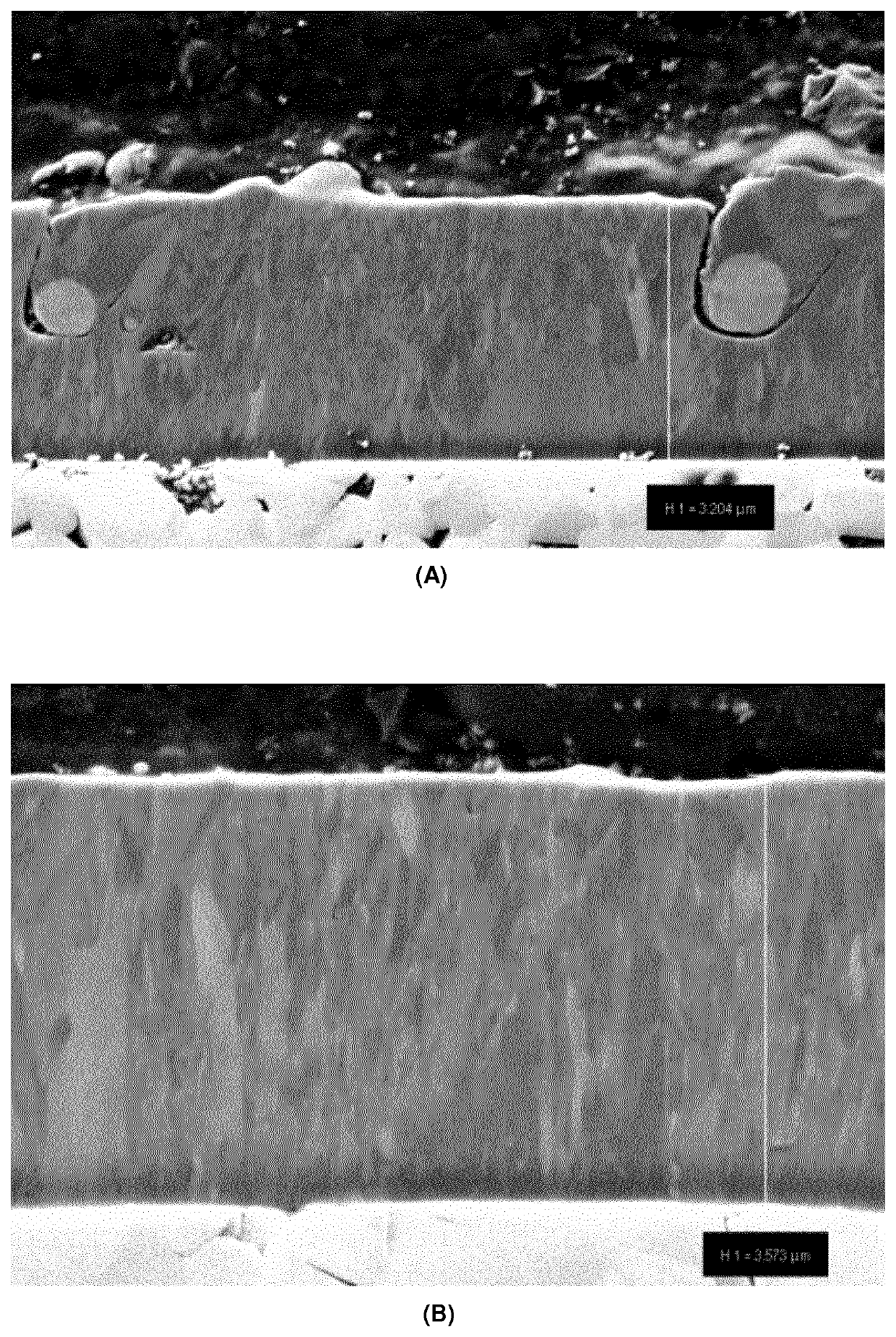Wear resistant PVD tool coating containing TiAlN nanolayer films
a technology of tialn nanolayer and tool, which is applied in the direction of manufacturing tools, superimposed coating process, vacuum evaporation coating, etc., can solve the problems of undetected high surface roughness of deposited layers and avoid extremely complex layers, and achieve high young's modulus (modulus of elasticity), improve wear resistance, and high hardness
- Summary
- Abstract
- Description
- Claims
- Application Information
AI Technical Summary
Benefits of technology
Problems solved by technology
Method used
Image
Examples
example 1
Deposition of Coatings According to the Invention and Comparative Coatings
[0079]In the following examples of the preparation of cutting tools according to the present invention and of comparative examples cemented carbide cutting tool substrate bodies (composition: 12 wt-% Co, 1.6 wt-% (Ta, Nb)C, balance WC; WC grain size: 1.5 μm; geometry: ADMT160608R-F56) were coated in a PVD system as indicated above. The residual stress at the surface of the substrate, measured prior to heating within the deposition chamber, was +200 MPa, i.e., a low tensile residual stress.
[0080]Prior to the deposition, the substrate bodies were pretreated by ultrasonic cleaning in ethanol and plasma cleaning. The PVD reactor was evacuated to 8×10−5 mbar, and the substrate was pre-treated at 550° C.
[0081]For the deposition of the (Ti,Al)N coatings, two types of targets with different atomic ratios of Ti:Al were used to produce alternately stacked (Ti,Al)N sub-layers being different in respect of the atomic rati...
example 2
Residual Stress, Hardness and Young's Modulus
[0084]For the (Ti,Al)N sub-layer stacks L1 and L2, deposited according to example 1, residual stress, hardness and Young's modulus were measured, as described above. Since the parameters during the deposition of an individual (Ti,Al)N sub-layer stacks L1 or L2, respectively, were held constant, the residual stress within an individual (Ti,Al)N sub-layer stack was constant, but differing from one individual layer stack to another one due to the different compositions and depending on the applied arc current. As described above, each of the (Ti,Al)N sub-layer stacks L1 and L2, respectively, was deposited immediately on the surface of the substrate. The thicknesses of the layer stacks was about 2-4 μm. The results are shown in the following table 2.
[0085]
TABLE 2(Ti,Al)NArc Cur-Pres-Resid-sub-layerrent / sureualVickersYoung'sstackstarget(N2)StressHardnessModulusSample[L1, L2][A][Pa][MPa][HV][GPa]S1L110010+2863234472S2L115010+3483407467S3L120010...
example 3
[0089]To compare the influence of the nitrogen pressure in the deposition process, two (Ti,Al)N sub-layer stacks of the type L2 were deposited at 4 Pa and 10 Pa, respectively, and surface roughness measurements were carried out. The results are shown in the following table 2. SEM cross sections of the samples are shown in FIG. 1. It can clearly be seen that the sample deposited at 4 Pa(FIG. 1A), shows larger droplets than the sample deposited at 10 Pa(FIG. 1B). Accordingly, the sample deposited at 10 Pa exhibits a much smoother surface roughness. It has been observed that, generally, smoother surfaces with less droplets and defects are obtained if higher pressure is applied during the deposition process.
[0090]
TABLE 3(Ti,Al)NArcSurfaceSurfacesub-layerCurrent / PressureRoughnessRoughnessstacksTarget(N2)SaSqSample[L1, L2][A][Pa][nm][nm]S7L21504123181S8L21501064125
PUM
| Property | Measurement | Unit |
|---|---|---|
| thickness | aaaaa | aaaaa |
| thickness | aaaaa | aaaaa |
| thickness | aaaaa | aaaaa |
Abstract
Description
Claims
Application Information
 Login to View More
Login to View More - R&D
- Intellectual Property
- Life Sciences
- Materials
- Tech Scout
- Unparalleled Data Quality
- Higher Quality Content
- 60% Fewer Hallucinations
Browse by: Latest US Patents, China's latest patents, Technical Efficacy Thesaurus, Application Domain, Technology Topic, Popular Technical Reports.
© 2025 PatSnap. All rights reserved.Legal|Privacy policy|Modern Slavery Act Transparency Statement|Sitemap|About US| Contact US: help@patsnap.com

